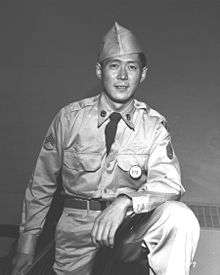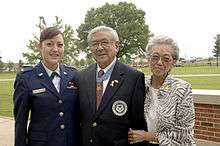Hiroshi H. Miyamura
Hiroshi H. "Hershey" Miyamura (born October 6, 1925) is a retired United States Army soldier and a recipient of the Medal of Honor, the United States military's highest award for valor, for his actions during the Korean War.[1][2] While he was held as a prisoner of war, the award was classified as top secret.
Hiroshi H. Miyamura | |
|---|---|
 Miyamura as a Staff Sergeant | |
| Nickname(s) | Hershey |
| Born | October 6, 1925 Gallup, New Mexico |
| Allegiance | United States |
| Service/ | United States Army |
| Years of service | 1945–1953 |
| Rank | Staff Sergeant |
| Unit | 100th Infantry Battalion, 442nd Infantry Regiment 2nd Battalion, 7th Infantry Regiment |
| Battles/wars | World War II Korean War |
| Awards | Medal of Honor Meritorious Service Medal Purple Heart |
| Other work | Automobile mechanic and service station owner |
Early life
Miyamura was born in Gallup, New Mexico, to Japanese immigrant parents, making him a Nisei, a second-generation Japanese American.[3] His parents had moved there in 1923 and bought a 24-hour diner.[2] He was the fourth of nine children. His mother died when he was 11. He got the nickname "Hershey" because one of his teachers could not pronounce his first name correctly.[2]
Military service
World War II
When the United States entered World War II, President Franklin D. Roosevelt ordered the relocation and internment of Japanese Americans due to fears that some would turn out to be traitors. However, for communities outside the sensitive coastal "military zone", this was not mandatory, and local authorities could decide what they wanted to do. In Gallup, the Japanese-American residents were left alone.[2]
Miyamura joined the United States Army in January 1945.[4] He volunteered to be part of the all-Nisei 100th Infantry Battalion,[5] 442nd Infantry Regiment, where he trained as a machine gunner.[6] This army unit was mostly made up of Japanese-Americans from Hawaii and the mainland.[7] He was discharged from the army shortly after Japan surrendered. He later enlisted in the United States Army Reserve.
Korean War
Miyamura was recalled to active duty following the start of the Korean War, arriving in North Korea in November 1950.[2] He was awarded the Medal of Honor for his actions on April 24–25, 1951, south of the Imjin River[8] near Taejon-ni (Daejeon-ni) in Yeoncheon County,[9] while serving as a corporal in the 2nd Battalion, 7th Infantry Regiment, 3rd Infantry Division. During a night attack by the Chinese, he saw that his squad could not hold much longer, so he ordered his men to retreat. He remained behind to cover their withdrawal.
Miyamura was captured immediately after the actions that led to his award. As he and other prisoners of war (POWs) were marched away, he helped his wounded friend Joe Annello keep moving, but the North Koreans threatened to shoot him if he did not leave Annello behind. Straggling POWs were routinely killed. Miyamura refused, but Annello himself convinced Miyamura to put him down. Annello survived the war and later visited Miyamura in Gallup. The POWs were forced to march 300 miles (480 km) over five weeks with little food.[2]
Miyamura's was the first Medal of Honor to be classified Top Secret. As Brigadier General Ralph Osborne explained to Miyamura and a group of reporters upon notifying them of his medal, "If the Reds knew what he had done to a good number of their soldiers just before he was taken prisoner, they might have taken revenge on this young man. He might not have come back."
Miyamura was held for 28 months. Following his release on August 20, 1953, he was informed that he had been awarded the Medal of Honor and promoted to sergeant. He was repatriated to the United States and honorably discharged from the military shortly thereafter. His medal was presented to him by President Dwight D. Eisenhower in October 1953 at the White House.[10]
Medal of Honor citation
Rank and organization: Corporal, U.S. Army, Company H, 2nd Battalion, 7th Infantry Regiment, 3rd Infantry Division
Place and date: Near Taejon-ni, Korea, April 24, and April 25, 1951
Entered service at: Gallup, N. Mex. Birth: Gallup, New Mexico
G.O. No.: 85, November 4, 1953.
Citation:
Cpl. Miyamura, a member of Company H, distinguished himself by conspicuous gallantry and intrepidity above and beyond the call of duty in action against the enemy. On the night of 24 April, Company H was occupying a defensive position when the enemy fanatically attacked threatening to overrun the position. Cpl. Miyamura, a machinegun squad leader, aware of the imminent danger to his men unhesitatingly jumped from his shelter wielding his bayonet in close hand-to-hand combat killing approximately 10 of the enemy. Returning to his position, he administered first aid to the wounded and directed their evacuation. As another savage assault hit the line, he manned his machinegun and delivered withering fire until his ammunition was expended. He ordered the squad to withdraw while he stayed behind to render the gun inoperative. He then bayoneted his way through infiltrated enemy soldiers to a second gun emplacement and assisted in its operation. When the intensity of the attack necessitated the withdrawal of the company Cpl. Miyamura ordered his men to fall back while he remained to cover their movement. He killed more than 50 of the enemy before his ammunition was depleted and he was severely wounded. He maintained his magnificent stand despite his painful wounds, continuing to repel the attack until his position was overrun. When last seen he was fighting ferociously against an overwhelming number of enemy soldiers. Cpl. Miyamura's indomitable heroism and consummate devotion to duty reflect the utmost glory on himself and uphold the illustrious traditions on the military service.[1]
Personal life

.jpg)
Miyamura married Terry Tsuchimori. He has three children and four grandchildren. One grandchild, Marisa, is an officer in the United States Air Force. He has resided in Gallup, New Mexico, since his discharge from the army, where he established a career as an automobile mechanic and service station owner.[2] Miyamura remains active in supporting fellow veterans including work with the Wounded Warrior Project. Miyamura is a Lifetime Member of Veterans of Foreign Wars Post 1. On Memorial Day 2018, his story was portrayed during the National Memorial Day Concert on the West Lawn of the US Capitol in Washington, D.C.
In recognition of Miyamura's activities involving youth in his community, he received the 2014 Director's Community Leadership Award from the Albuquerque division of the FBI.[11]
As the 2014 Nisei Week Grand Marshal, Miyamura led the Grand Parade on August 10, 2014.[12][13]
Namesakes
In his hometown, Gallup, New Mexico, an area is named Miyamura in his honor,[14] as are Hiroshi H. Miyamura High School[15] and the Miyamura Overpass, an interchange on I-40.[16][17]
See also
- Battle of Yultong
- List of living Medal of Honor recipients
- List of Korean War Medal of Honor recipients
- Medal of Honor (TV series), Miyamura is featured in Season 1, Episode 4
Further reading
- Okamoto, Vincent H. (2012). Forged in fire : the saga of Hershey and Joe (First ed.). Los Angeles: Nikkei Writers Guild. ISBN 0982142188.
References
- US Army Center of Military History, "Medal of Honor Recipients, Korean War"; retrieved 2012-12-24.
- Mozingo, Joe (July 3, 2017), "Hiroshi Miyamura and his hometown had a lot in common. They believed in America.", Los Angeles Times
- Japanese American Veterans Association, "The Nisei Legend of the Korean War"; retrieved 2012-12-24.
- U.S. National Archives and Records Administration (NARA), WWII Army Enlistment Record #39868194 (Miyamura, Hiroshi); retrieved 2012-12-24.
- Go for Broke National Education Center, "About Us, Veterans Honor Guard" Archived 2012-10-28 at the Wayback Machine; retrieved 2012-12-24.
- Lange, Katie (May 14, 2017). "Korean War POW Earns Medal of Honor for Saving His Unit". DoDLive. Department of Defense. Retrieved 28 June 2018.
- "100th Battalion, 442nd Infantry" at Global Security.org; retrieved 2012-12-24.
- "Miyamura, Hiroshi" (Vimeo). vimeo.com. Medal of Honor Foundation. 15 August 2013. Retrieved 16 July 2019.
- "대한민국 지켜낸 영웅들의 공로 기억합니다" (in Korean). 28 July 2014. Retrieved 28 June 2018.
- Eric S. Bartelt (24 April 2001). "Secret Hero Recounts his Unforgettable Korean War". American Forces Press Service. US Department of Defence. Retrieved 24 December 2012.
- "Albuquerque". FBI. Retrieved 25 December 2018.
- "INTRODUCING THE 2014 NISEI WEEK GRAND MARSHAL AND PARADE MARSHAL". Rafu Shimpo. August 7, 2014. Retrieved August 26, 2014.
- "Celebrating Past and Future at Nisei Week – Little Tokyo Festivities Include a Parade, Ramen Festival and Traditional Dancing". LADTNEWS. August 12, 2014. Retrieved August 26, 2014.
- City of Gallup Growth Management Master Plan, "IV. Land Use Element" (August 2009), p. IV-23 [PDF 23 of 60]; retrieved 2012-12-24.
- Gallup-McKinley County Schools, "High Schools" Archived 2012-02-06 at the Wayback Machine; Hiroshi H. Miyamura High School website; retrieved 2012-12-24.
- New Mexico Department of Transportation, Initial Evaluation of Alternatives, Allison Road Corridor and Interstate 40 Interchange Study, NMDOT Project Number SP-GA-5459(201)/SP-GA-5459(202), CN C7G801/C7G802 September 2010; "Table 4-6: I-40 Total Crashes by Mile Post," p. 4-32 [PDF 51 of 210]; retrieved 2012-12-24.
- City of Gallup, p. IV-45 [PDF 45 of 60]; retrieved 2012-12-24.
External links
![]()
- "Home of Heroes profile". Archived from the original on July 13, 2016. Retrieved October 5, 2010.
- "Hiroshi Miyamura and his hometown had a lot in common. They believed in America". Retrieved July 4, 2017.